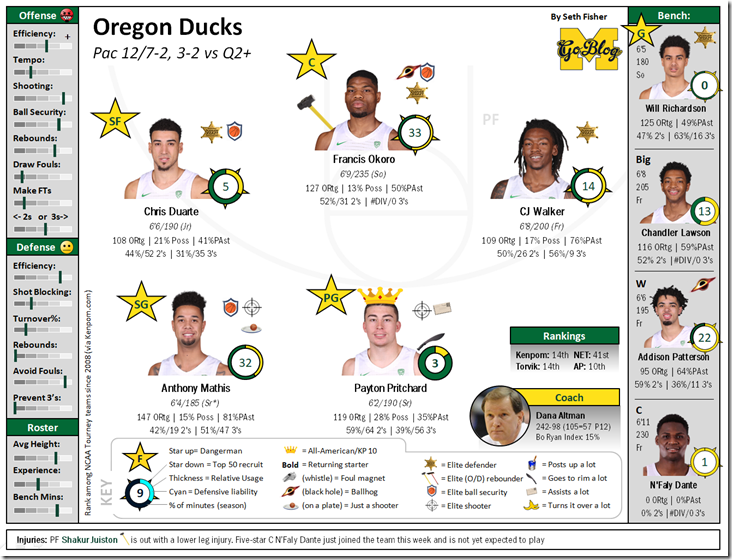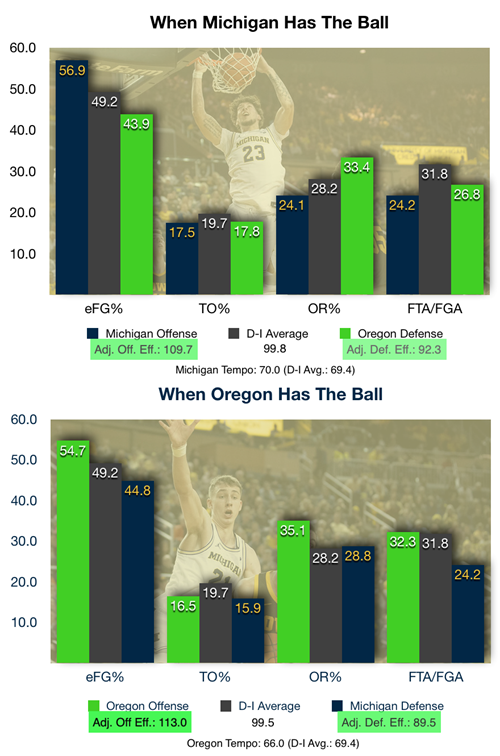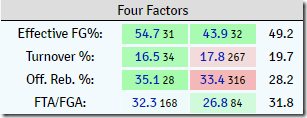
Hoops Preview: Oregon 2019

THE ESSENTIALS
| WHAT | #17 Michigan (8-2) vs #14 Oregon(7-2) |
|
|---|---|---|
| WHERE | Crisler Arena Ann Arbor, MI |
|
| WHEN | Noon Eastern | |
| THE LINE | Michigan –3 (KenPom) Michigan –3.7 (Torvik) |
|
| TELEVISION | CBS |
THE US
Seth's graphic:
click for big
Michigan will try to bounce back from a loss at Illinois where they got crammed on the boards and couldn't make it up since they shot 3/18 from three. That'll happen but it doesn't make it any less frustrating. Still waiting for the Franz breakout, which is coming. Promise?
[Hit THE JUMP for the rest of the preview.]
THE THEM
click for big; note that Dante is not expected to play
Oregon enters as a top-15 team on Kenpom, with wins over top-50 opponents Memphis(#34), Houston(#31), and Seton Hall(#18), the latter by two points in Atlantis. They ended up going 1-2 in the Bahamas, losing to Gonzaga by a point in OT and to UNC by four. Like Michigan, they've got tomato cans lined up for the rest of the nonconference; this is their last opportunity for a resume-boosting win before Pac-12 play begins.
This is the space to talk about Oregon's matchup zone. Do you like watching smooth, flowing offense? Well, get bent, buddy, because you're gonna get jacked-up threes and like it. UMHoops and the Athletic both have breakdowns of Dana Altman's zone, which starts with the half-ass 1-2-2 press that all defenses should start with to burn time, sets up as a 2-3 zone, and then has Oregon players follow guys all over the court as it evolves into something closer to man-to-man when necessary:
Once the offense gets into the half court, it looks like Oregon is in a regular zone defense.
But as the ball starts to move, the Ducks begin to match up. They still have areas of the floor they’re responsible for, but there are no set rules against a big man straying out to the perimeter or a guard ending up near the basket. “As long as guys are matched up and have got a guy,” assistant coach Mike Mennenga said, “we don’t care really who’s on who.”
Imagine the dilemma as an opposing coach. Do you call a zone set or a man-to-man set? No. 13 seed UC Irvine, which plays No. 12 Oregon on Sunday for a spot in the Sweet 16, plans to run its man-to-man offense. “You have to not try to overthink it,” Anteaters assistant coach Ryan Badrtalei said. But this is what often happens, and that bleeds the shot clock.
16% of Oregon defensive possessions go 25+ seconds into the shot clock, which is a big number. Over half of those are threes going down at a 31% clip.
Unfortunately for the Ducks they haven't been able to replace Kenny Wooten, who didn't do a ton on offense but was a top-10 shotblocker. They've regressed in most areas and currently check in 52nd in defensive efficiency, down from 13th a year ago. Inexperience has a lot to do with that. Other than their star PG, every Oregon player is in his first or second year in Altman's system, and there are only two second-year guys.
PERSONNEL
This will be Zavier Simpson's biggest defensive test of the year as he meets KPOY #10 Payton Prichard, who's rather blown up in his senior year. Prichard was good a year ago, with a top-200 assist rate and an acceptable TO rate, but was iffy shooting (51/33) on 21% usage. So far this year he's managed to add both a bunch of usage and efficiency, popping into the top 50 in assist rate while shooting 59/39. The two-point shooting bump appears to be an effect of early season buy games; against high-majors Prichard is 12/30 inside the line.
The three-point shooting is a return to his sophomore form, when he hit 41% on high volume, and is more likely to be sustainable. Prichard is also in the mid-40s in the midrange and a knockdown FT shooter. He's a sniper.
He's also a shot creator. Even last year, when his usage was average, just about everything he put up was unassisted; that is again the case except now he's shooting just under half his threes off the bounce as well. A lot of Oregon's offense boils down to "Prichard, do something," which is why his TO rate has bounced up with the extra usage.
Can't go under screens with Prichard and drop coverage might be inadvisable, so expect Michigan to at least look at hedging. The "do something" portion of the show is going to be a tall order against Simpson.
SG Anthony Mathis, who you may remember Michigan pursuing as a grad transfer out of New Mexico, is Just A Shooter and a deadly one. He's coming off high-volume years in which he shot 47% and 41% from three and is at 51% so far this year with exactly two turnovers on the season. The usual Just A Shooter things happen inside the line, where Mathis was at 39% last year and is at 42% this year.
At New Mexico Mathis had some hand in the playmaking; at Oregon he sits outside the line hunting shots, the end. He was notably miserable in the Bahamas, going 2/5 from two and 1/12 from three over the course of the tournament.
Junior wing Chris Duarte is fresh out of JUCO and plays like a D-I basketball player surrounded by JUCO guys. He'll attack downhill and hump up whatever he gets—about 15% of his twos are assisted. This is usually not a great shot; he's hitting 48% at the rim, and despite his propensity to shoot downhill he's only got 9 FTAs on the season. On the bright side he'll grab some OREBs and his TO rate is pretty good.
You wanna see some dudes balling in t-shirts?
JUCO is wild, man.
UNLV grad transfer Shakur Juiston is out; 6'8" freshman CJ Walker got a start and 22 minutes in his absence against Hawaii. This may actually be to Oregon's advantage if Walker knows what to do on defense. Juiston is Oregon's second highest usage player despite a 92 ORTG. Walker was the #28 guy on the composite last year because he's an extremely athletic 6'8" guy with range. Oregon's thrived on off-ball PF shot blockers in their zone and Walker is potentially the next in that line. He's just outside the top 200 in block rate already. That's not Wooten but it's a big improvement on Juiston.
Walker's shooting 50/56 in the extremely early going, but he's dependent on others to create for him. He's the finisher.
At center Oregon splits minutes between sophomore Francis Okoro and freshman Chandler Lawson, who are statistically similar: low usage guys hitting 51% from two with no range and eh block rates. Okoro does have a top 50 OREB rate and a junior Teske TO rate—he's in fact #1 nationally in TO rate. Both guys are back to the basket posts who will generate about half their shots themselves; neither is particularly likely to be effective against Jon Teske since they'e 6'9" and 6'8", respectively.
With Walker promoted, Oregon's bench aside from the center platoon is two guys. Sophomore Will Richardson is essentially a sixth starter; he's listed as such on Kenpom because he's getting the third-most minutes on the team despite coming off the bench. Last year he was a high-TO wing operating mostly inside the line who shot 56/28; this year he's shooting 47/63 in the early going, though that latter number is on just 16 attempts. He's cut down his TOs quite a bit.
The last Oregon player you're likely to see for more than a minute or two is freshman Addison Patterson. Despite being a top 50 recruit himself Patterson has been overwhelmed by high-major competition thus far, shooting 3/12 from two and 2/6 from three with a bunch of turnovers. He'll probably put it together at some point; hopefully that's not Saturday.
THE RELEVANT NUMBERS
Oregon factors:
left: offense, right: defense
If those defensive factors veritably scream zone, well just let me add that Oregon is 304th nationally at preventing threes from going up but opponents are only hitting at 28%.
Oregon's defensive step back is largely because of a lack of havoc. After finishing top 20 in blocks and steals last year Oregon's fallen to the middle of the pack in both; they've also been extremely bad at forcing TOs more generally.
THE KEYS
Get into your actions quickly. Oregon wants to bleed the clock and put Michigan in late-clock situations where they'll be forced to huck something up. Michigan's done a decent job of dealing with half-ass 1-2-2 presses, even getting some transition buckets off breaking it.
Boards. Michigan got crushed against Illinois and as you can see above Oregon provides a similar challenge when M is on defense. When M is on offense Oregon is ripe for the picking despite having a bunch of games against low-majors that Kenpom does not attempt to correct for in raw four factors numbers. A repeat Brandon Johns-vs-Iowa game would go a long way towards a win.
X vs Pritchard. Oregon will screen for him a bunch but a lot of Pritchard's shot creation is just going at a dude and either drawing help or getting up an iffy shot. A vintage X destroys your point guard game would also go a long way towards a win.
Martelli time? I continue to believe Michigan's increased proficiency at doing stuff against zones is a Phil Martelli thing. Did Martelli play a matchup zone against Hoboken State in the mid-80s? Maybe. Actually this might be a Howard thing since matchup zones are something NBA teams have dabbled with from time to time since the introduction of the defensive three seconds call.
Body clock theory. This game is going to happen at 9 AM Pacific time.
Hit two garbage shots at the end of the clock. The Spike vs Syracuse plan.
THE SECTION WHERE I PREDICT THE SAME THING KENPOM DOES
Michigan by 3.
December 13th, 2019 at 1:08 PM ^
Thanks, Ace. I mean Seth. I mean
December 13th, 2019 at 1:50 PM ^
Does KenPom factor in the Body Clock theory? If not, add 10 points to Michigan’s margin. I hope we respond like we did after losing to Louisville. This could be over by halftime, or not.
December 13th, 2019 at 2:14 PM ^
I love what Oregon does on defense. I played on a HS team that annihilated people we should have and beat teams that we had no business competing with-with a similar defensive strategy. We pressed 1-2-1-1 three different ways then dropped back into a 2-3 then rotated to other zones and trapped...they never knew what was coming. We would pick up in man if we missed but then go into our match-up as they went into a set offense. How we pressed was predicated upon whether our guards, forwards or center scored. Stockbridge, with their 6-11 All-American center was the only team we could not tie into knots. This is one of the most dumbfounding things to me about college basketball-that everyone does not defend like this...especially with a shot clock.
December 13th, 2019 at 7:32 PM ^
"they never knew what was coming"
no video recording equipment owned by high schools back in the 50s?
seriously though, this doesn't work very well at a college level with the skills these guys have and the preparation they do.
it works a lot better at lower levels where little or no scouting is done (and hence there's no opponent specific preparation) and players aren't skilled enough to deal with traps and things they don't normally see.
at higher levels this kind of stuff gets punished a lot easier, especially as guys have gotten better at shooting threes which these things expose a defense to
speaking of which, there probably wasn't a three point line when you played HS so that changes things A LOT.
December 14th, 2019 at 8:44 AM ^
It was the late 60 early 70s. There were tapes. You could have scouted us to death-we could (still) make life hell for you.
The three point line would not have changed the effectiveness. It is interesting that people believe the 2-3 zone is the most sound of zones to play-it is the worst...holes everywhere. We set up in the 2-3 because that was the zone that most played and what most prepared for. We did not simply rotate to a different zone once a possession-we would seamlessly flip multiple times. The "point" zones are where it is at because it allows you to keep significant on-ball pressure on the perimeter while also taking away the driving lanes-and today they would also allow you to run shooters off the arc. Here, the ability to respond to an offense is significantly greater than with a straight man-individually you defend strongly with man principles without the risk of being isolated. There are no down-sides to this system as it always keeps your defenders in their most advantageous positions of play-never out of position...no 7 footer required to switch and cover a guard or vice versa.
The effectiveness of this system has nothing to do with skill level. Here, you can prepare until the cows come home-but today that shot clock is running...that is much more monumental than the (new) 3-point line.
December 13th, 2019 at 2:22 PM ^
This would be a big bounce-back win for this team. And they can add ANOTHER top 10 win to the resume. GO GET 'EM!!
December 13th, 2019 at 3:41 PM ^
Hot damn, 6 top 50 recruits in their rotation (5 since 1 dude is injured). I feel like I haven't heard of that many on one team outside of the usual suspects (Duke, UNC, Kentucky, Kansas, Arizona).
December 13th, 2019 at 4:58 PM ^
THIS game is CRUCIAL...lose this and we are staring at 3 losses in 4 games so this truly is a Statement game against a top 10 ranked team and make no mistake about it this WILL NOT be a easy game at all
December 13th, 2019 at 5:13 PM ^
Could you help some of us regular people and go lighter on the abbreviations!!
December 13th, 2019 at 10:31 PM ^
I think you'll need to contact the UO AD to find out what TTATT means.
December 14th, 2019 at 1:59 AM ^
Yeah I knew the logo somehow connected to Phil Knight's son who passed away but I couldn't remember how
Nice gesture, but certainly an awfully designed logo
December 14th, 2019 at 8:49 AM ^
I’m excited for this game. Go Blue!
December 14th, 2019 at 10:09 AM ^
Please add a banana peel to Wagner's profile - he turns into Bambi on skates with the ball in traffic.






Comments